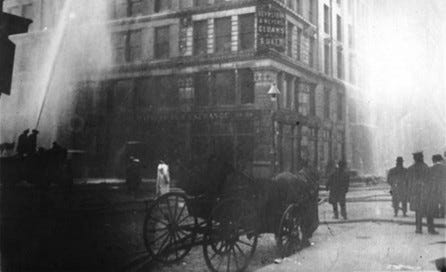Moving Forward Together: Day 25
March 25: The Triangle Shirtwaist Factory Fire & the Crone’s Cry for Justice
Photo credit: By Unknown author - http://www.ilr.cornell.edu/trianglefire/primary/photosIllustrations/slideshow.html?image_id=746&sec_id=3#screen, Public Domain, https://commons.wikimedia.org/w/index.php?curid=14685005
Some fires destroy. Others ignite revolutions.
On March 25, 1911, 146 people—mostly young immigrant women and girls—died in the Triangle Shirtwaist Factory fire in New York City. Trapped by locked doors, narrow stairwells, and inadequate fire escapes, many jumped from windows to escape the flames. It was one of the deadliest industrial disasters in American history—and also one of the most galvanizing.
This tragedy forced a nation to confront the cost of unchecked greed, unsafe labor conditions, and the exploitation of women and immigrants. It marked a turning point in the fight for workers' rights, workplace safety, and labor justice—a legacy built on grief, fury, and refusal to let these deaths be in vain.
The Triangle Shirtwaist Factory, located in Manhattan’s Greenwich Village, was a bustling garment shop producing women’s blouses (“shirtwaists”). The workers were mostly teenage girls and young women, recent immigrants from Italy, Russia, and Eastern Europe. They worked six or seven days a week, often over 12 hours a day, for meager wages in crowded, poorly ventilated rooms.
Their bosses—wealthy men with no risk to their own lives—locked exit doors to prevent unauthorized breaks and theft. So when fire broke out, there was no escape.
The tragedy was not an accident—it was a predictable result of exploitation, of valuing profits over people, of believing poor immigrant women were disposable.
The fire shook the country. For many, it was the first time they saw the true human cost of industrial capitalism. It sparked a wave of public outrage, protests, and investigations that led to:
🔹 The growth of the International Ladies' Garment Workers’ Union (ILGWU), which had already been organizing women for fair wages, shorter hours, and safer conditions.
🔹 The emergence of fierce labor advocates like Clara Lemlich, who helped spark the Uprising of the 20,000 garment workers in 1909; Rose Schneiderman, who declared that too many lives were lost because “the lives of women count for nothing”; and Frances Perkins, who witnessed the fire and later became FDR’s Secretary of Labor, shaping the New Deal.
🔹 The creation of the Factory Investigating Commission (1911), which inspected thousands of workplaces and laid the groundwork for over 30 new safety and labor laws in New York alone—including mandates for fire exits, sprinklers, and unlocked doors.
🔹 The eventual passage of the Fair Labor Standards Act (1938), establishing the 40-hour workweek, minimum wage laws, and child labor restrictions—reforms that trace their roots to the factory floor where women once burned behind locked doors.
The Crone Remembers: Work, Fire, and Revolution
The Crone does not flinch from the past. She holds the names of the lost. She remembers how they died, and she demands that their deaths were not for nothing. She knows that the rights we have now were paid for in blood, in tears, in fire.
She teaches us that:
Women’s labor has always been undervalued and exploited.
Immigrant women have always been at the forefront of labor justice.
It is our responsibility to protect what was won and keep fighting for what is still needed.
To be a Crone is to know where the fire started and to carry its embers forward—not to burn, but to light the way.
A Spell to Protect Workers & Keep the Flame of Justice Alive
This spell is for honoring the women lost in the Triangle Shirtwaist Factory fire, for protecting workers today, and for keeping alive the flame of justice, reform, and revolution.
What You’ll Need:
A red candle (for fire, passion, and activism)
A piece of cloth or fabric scrap (to represent labor and textile work)
A slip of paper (to write your vow to support workers’ rights)
A pin or needle (symbolizing the seamstresses and their tools)
The Ritual:
1. Light the Flame of Remembrance
Light the red candle, saying:
"For the 146 souls who worked and died,
I light this flame.
For the women who sewed, who struck, who spoke,
I carry their fire."
2. Name the Injustice & the Fight
Hold the cloth and pin, thinking of workers today—those who are underpaid, overworked, exploited or silenced.
Whisper:
"Their struggle is not over.
Their fight is not finished.
I stand with them, across time and across fire."
3. Write & Pin Your Promise
On the slip of paper, write a commitment: to support unions, to buy ethically, to vote for labor protections, to speak out.
Pin the note to the cloth, anchoring your vow in the legacy of working women. Say:
"I do not forget.
I will not be silent.
I carry their legacy forward."
4. Seal the Spell & Carry It Forward
Let the candle burn as long as you safely can, then snuff it out. Keep the pinned cloth somewhere you’ll see it—a reminder that every shirt we wear, every product we buy, is touched by someone’s labor—and someone’s risk.
The women of the Triangle Shirtwaist Factory are not just victims of a fire. They are ancestors of resistance, of reform, of labor rights that many take for granted today.
Let us honor them not just with remembrance, but with action. Let us stoke the flames of justice—not to destroy, but to illuminate.
We move forward together—rooted in history, fueled by resistance, and weaving the future with our own hands.




